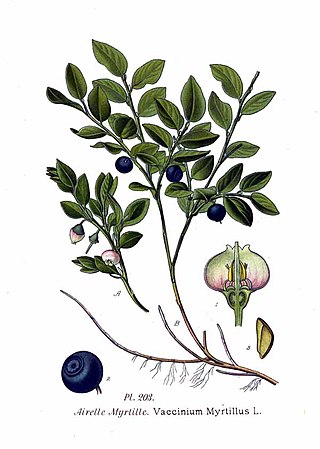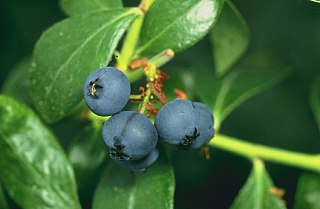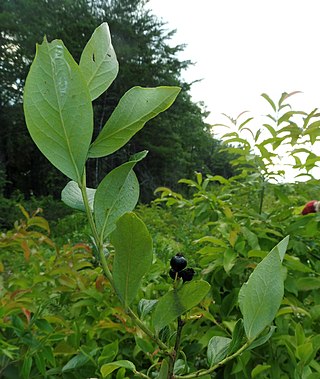
Vaccinium is a common and widespread genus of shrubs or dwarf shrubs in the heath family (Ericaceae). The fruits of many species are eaten by humans and some are of commercial importance, including the cranberry, blueberry, bilberry (whortleberry), lingonberry (cowberry), and huckleberry. Like many other ericaceous plants, they are generally restricted to acidic soils.

Bilberries or blueberries are a primarily Eurasian species of low-growing shrubs in the genus Vaccinium, bearing edible, dark blue berries. The species most often referred to is Vaccinium myrtillus L., but there are several other closely related species.

Vaccinium virgatum is a species of blueberry native to the Southeastern United States, from North Carolina south to Florida and west to Texas.

Vaccinium myrtillus or European blueberry is a holarctic species of shrub with edible fruit of blue color, known by the common names bilberry, blaeberry, wimberry, and whortleberry. It is more precisely called common bilberry or blue whortleberry to distinguish it from other Vaccinium relatives.

Vaccinium angustifolium, commonly known as the wild lowbush blueberry, is a species of blueberry native to eastern and central Canada and the northeastern United States, growing as far south as the Great Smoky Mountains and west to the Great Lakes region. Vaccinium angustifolium is the most common species of the commercially used wild blueberries and is considered the "low sweet" berry.

Vaccinium corymbosum, the northern highbush blueberry, is a North American species of blueberry which has become a food crop of significant economic importance. It is native to eastern Canada and the eastern and southern United States, from Ontario east to Nova Scotia and south as far as Florida and eastern Texas. It is also naturalized in other places: Europe, Japan, New Zealand, the Pacific Northwest of North America, etc. Other common names include blue huckleberry, tall huckleberry, swamp huckleberry, high blueberry, and swamp blueberry.

Vaccinium myrtilloides is a shrub with common names including common blueberry, velvetleaf huckleberry, velvetleaf blueberry, Canadian blueberry, and sourtop blueberry. It is common in much of North America, reported from all 10 Canadian provinces plus Nunavut and Northwest Territories, as well as from the northeastern and Great Lakes states in the United States. It is also known to occur in Montana and Washington.

Vaccinium darrowii, with the common names Darrow's blueberry, evergreen blueberry, scrub blueberry, is a species of Vaccinium in the blueberry group.

Vaccinium elliottii is a species of Vaccinium in the blueberry group. It is native to the southeastern and south-central United States, from southeastern Virginia south to Florida, and west to Arkansas and Texas.

Vaccinium uliginosum is a Eurasian and North American flowering plant in the genus Vaccinium within the heath family.

Vaccinium crassifolium, the creeping blueberry, is a species of Vaccinium in the heath family. It is native to the four southeastern U.S. states of Virginia, North Carolina, South Carolina, and Georgia. It is an evergreen shrub with shiny dark green to bronze leaves.

Blueberries are a widely distributed and widespread group of perennial flowering plants with blue or purple berries. They are classified in the section Cyanococcus within the genus Vaccinium. Vaccinium also includes cranberries, bilberries, huckleberries and Madeira blueberries. Commercial blueberries—both wild (lowbush) and cultivated (highbush)—are all native to North America. The highbush varieties were introduced into Europe during the 1930s.

Vaccinium ovalifolium is a plant in the heath family with three varieties, all of which grow in northerly regions.

Vaccinium caesariense is native to the Eastern United States. It is a species in the genus Vaccinium, which includes blueberries, cranberries, huckleberry, and bilberries.

Vaccinium myrsinites is a species of flowering plant in the heath family known by the common name shiny blueberry. It is native to the southeastern United States from Alabama, Georgia, South Carolina and Florida. It may occur as far west as Louisiana.

Vaccinium pallidum is a species of flowering plant in the heath family known by the common names hillside blueberry, Blue Ridge blueberry, late lowbush blueberry, and early lowbush blueberry. It is native to central Canada (Ontario) and the central and eastern United States plus the Ozarks of Missouri, Arkansas, southeastern Kansas and eastern Oklahoma.
Vaccinium boreale, common name northern blueberry, sweet hurts, or bleuet boréal, is a plant species native to the northeastern United States and eastern Canada. It has been found in Québec, New Brunswick, Nova Scotia, Newfoundland and Labrador, Maine, New Hampshire, Vermont, and New York State. It grows in tundra, rocky uplands, and in open conifer forests at elevations up to 2,000 metres (6,600 ft).

Vaccinium fuscatum, the black highbush blueberry, is a species of flowering plant in the heath family (Ericaceae). It is native to North America, where it is found in Ontario, Canada and the eastern United States. Its typical natural habitat is wet areas such as bogs, pocosins, and swamps.

Vaccinium glaucoalbum, the grey-white blueberry, is a species of Vaccinium native to Nepal, east Himalaya, and Myanmar, and Tibet and Yunnan in China. An evergreen shrub with white-bloomed black berries, it has gained the Royal Horticultural Society's Award of Garden Merit as an ornamental. It grows in thickets and forest margins. Local people collect and eat the fruit.

Vaccinium cylindraceum, known by its common names such as Azores blueberry, is a semi-deciduous species of Vaccinium endemic to the Azores. It has gained the Royal Horticultural Society's Award of Garden Merit as an ornamental.



















